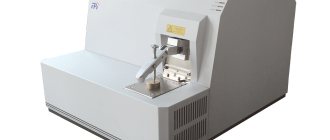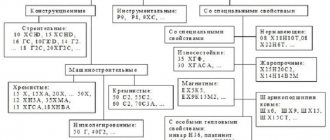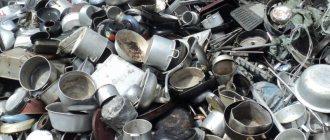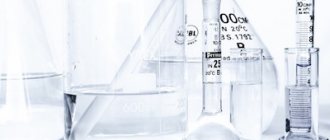Brief overview of methods
Analysis of metal composition by traditional methods of analytical chemistry is based on the ability to interact with reagents. The procedure includes sample preparation, weighing, titration; requires effort and time. Nowadays, chemical analysis of metal by classical analytical research is rarely carried out in practice. Determination of composition based on physical phenomena is fast and efficient. Thus, the frequently used spectral analysis of alloys has the following advantages:
- • efficiency of execution: • minimum number of auxiliary devices; • maximum accuracy of values; • ease of implementation; • possibility of carrying out in field and stationary conditions.
Reliable chemical analysis of the metal is carried out using modern spectral equipment that records the intensity of emission waves. Emission spectrometers of the domestic brand are reliable, easy to use, and affordable. Spectral analysis of steel and other materials is highly accurate and is used for certification.
Chemical analysis of metals
Chemical analysis methods are fundamental in determining the composition of various substances. Modern chemical analysis of metals and alloys is an important stage of examination, which is used to determine the quality of products and verify their compliance with current standards.
Without this procedure, technological processes cannot be carried out in the steel production industry; it is necessary when creating and producing new materials, as well as monitoring manufactured products by modern enterprises.
The quality and reliability of future products produced using metals and their alloys will depend on the correctness and accuracy of the analysis. However, very often there is a need to increase the efficiency of control, as well as to be able to automate control.
In this regard, physicochemical and physical methods for determining the composition of materials have been developed. Among these methods, one of the main places is occupied by spectral analysis.
Chemical and phase composition analyzers
Almost no branch of the industrial economy can function and develop normally without an accurate determination of the chemical composition of the materials used in production.
Metallurgy, mechanical engineering, petrochemical production, mining and manufacturing industries, cement production, as well as numerous research projects require the presence of modern analyzers of the chemical composition of metals and alloys.
MELITEK LLC offers enterprises, research centers, and institutes high-quality equipment designed for high-precision chemical and phase analysis of ores, analysis of alloys, metals, ceramics, soils and liquids.
We offer equipment that can be used in a wide variety of industries where analysis of the structural and phase composition or analysis of the chemical composition of alloys, ores or metals is required.
For example, a portable X-ray alloy analyzer will become an indispensable assistant where there is a need for express analysis of metal composition.
This can be sorting scrap metal, diagnosing the quality of parts during repair and technical work, incoming express diagnostics of the quality of raw materials supplied to the enterprise.
To carry out high-precision research, analysis of ores and analysis of alloys in the laboratories of the enterprise, MELITEK LLC supplies special stationary optical emission spectral analyzers of metals produced by Bruker (Germany), a leader in the production of equipment for the chemical analysis of metals and alloys, allowing to determine their structural and phase composition. These spectrometers allow high-precision certified analysis of various metals and their alloys. Such equipment is a necessary attribute in an enterprise that requires constant quality control of products. X-ray spectrometers and diffractometers from Bruker are also used for these purposes. The line of models produced by this leader in X-ray spectrometry is designed to meet a variety of needs for high-quality chemical and structural analysis of a variety of materials.
For the determination of “light elements” in solid materials such as oxygen, hydrogen, nitrogen, sulfur and carbon, Bruker offers modern analyzers of gas-forming elements.
All this equipment will allow your company to continuously monitor the quality of incoming raw materials and improve the level of products.
Optical emission analyzer of metals and alloys
The optical emission analyzer is a classic spectrometer equipped with a Paschen-Runge optical system with a focal length of 350 mm. Analyzers of metals and alloys, in comparison with the previous type of device, have a stationary design.
The main difference between this type of spectrometer and X-ray fluorescence portable metal analyzers is the ability to determine C (carbon in samples), S (sulfur) and P (phosphorus) with high accuracy, which makes it possible to analyze and sort steel by grade.
The devices are widely used in solving the following problems:
- At the entrance control,
- When restoring passports for industrial facilities,
- When sorting scrap metal,
- When selecting analogues of steels and alloys (Import substitution)
- In metallurgy in the production of steel.
It uses powerful software and a rugged, rugged housing to make it suitable for use in harsh industrial environments. The price set for this analyzer of the chemical composition of metals is fully justified by the capabilities of the equipment and the breadth of its application.
All analyzers are included in the state register of measuring instruments.
X-ray fluorescence analyzer of metals and alloys
Such equipment can be used when working with any material, regardless of its shape, size or weight. Thus, the inspected object can be wire, ready-made non-demountable structures, powder, alloy materials, etc.
- An analyzer of the chemical composition of metals of this type is used to carry out a number of operations:
- Organization of incoming quality control of alloys and steels.
- Sorting of scrap metal.
- Preparation of charge materials.
- Instant analysis. An X-ray fluorescent analyzer of the chemical composition of metals allows you to determine the grade of metal in a few seconds, and the production stage does not matter.
The price set for the analyzer of the chemical composition of metals allows for a relatively small fee to obtain a unique portable metal analyzer, with which you can instantly obtain data on the substance being studied, which is especially important in the conditions of a production or construction site.
All modern equipment is electronic devices, data from which can be transferred to portable, pocket computers, which significantly simplifies and speeds up the processing of the received information.
As for the principle on which the presented analyzer of metals and alloys works, its operation is based on the effect on the material under study through x-rays. Data on the properties of a material can be obtained by analyzing the degree and speed of penetration, reflection and scattering of rays.
Thus, the X-ray fluorescence analyzer can act as an analyzer of non-ferrous metals, ferrous, ferroalloys and many others.
Metal marking methods
First of all, the most popular method of applying markings to metal is dot impact. The essence of this method is to use a special machine with many precise needles, which, under high pressure, extrude the required image or inscription on the metal.
The next method is called tracing. It also uses a diamond-tipped needle, which literally draws tracks in the metal in the form of an image or inscription necessary for application.
The latest possible method of applying a logo to metal is called laser application. So, through the use of many mirrors and lenses, the laser beam is directed concentrated onto the metal and burns the necessary image directly onto the metal sheet.
The essence and possibilities of atomic emission measurements
Spectral analysis of metals is based on the ability of atoms to emit waves as a result of excitation. The process initiates spark, laser, arc, and other influences. The excitation source is located in the generator - the spectrometer unit, which can be easily replaced if necessary. The emission analyzer measures the intensity of optical waves emitted by atoms after transitioning to an excited state. Based on the wavelength and peak size in the spectrum, a chemical element is automatically identified and its concentration is calculated. Atomic emission spectroscopy allows you to analyze substances in various states of aggregation. A minimum amount of material is required for measurements. Through analysis on a stationary or mobile spectrometer, the grade of steel and the degree of purity of metals are determined; perform chemical analysis of metal alloys. The devices can determine the mass fractions of elements with a detection limit of 0.0001%
Non-destructive testing of metals, spectral analysis of product composition
Any foundry and metalworking production cannot do without control systems for its products. The decline in the quality of supplied products has become a big problem for domestic enterprises, which are now forced to purchase the required materials abroad. That is why an important factor in production is the control system of supplied products and product control.
Methods for controlling products in production
Chemical analysis methods are fundamental in determining the composition of various substances. Modern chemical analysis of metals and alloys is an important stage of examination, which is used to determine the quality of products and verify their compliance with current standards.
Without this procedure, technological processes cannot be carried out in the steel production industry; it is necessary when creating and producing new materials, as well as monitoring manufactured products by modern enterprises.
The quality and reliability of future products produced using metals and their alloys will depend on the correctness and accuracy of the analysis.
However, very often there is a need to increase the efficiency of control, as well as to be able to automate control. In this regard, physicochemical and physical methods for determining the composition of materials have been developed. Among these methods, one of the main places is occupied by spectral analysis.
Advantages of the method
Thanks to high selectivity, it is possible to quickly and with high sensitivity determine the chemical composition of the analyzed material. to study the composition of a metal by spectrum without affecting its suitability for use, i.e.
non-destructive testing of samples can be Despite the huge number of analytical techniques designed to study various objects, they are all based on a common principle: each chemical element has its own spectrum.
Thanks to the individuality of the spectra, it is possible to determine the chemical composition of the body. The comparative simplicity and versatility of spectral analysis have made the method the main method for monitoring the composition of a substance in metallurgy, mechanical engineering, and the nuclear industry. With its help, chemical ores and minerals are determined; non-destructive testing of metals occupies a special place in this area.
Principle of the method
To carry out the study, the substance must be evaporated, since the light emitted by a substance in the gaseous state is determined by the chemical composition of that substance, unlike the light emitted by solids or liquids. To evaporate and excite substances, high-temperature flames and various types of electrical discharges in gases are used: arc, spark, etc.
High temperatures in discharges (thousands and tens of thousands of degrees) lead to the disintegration of the molecules of most substances into atoms. Therefore, emission methods are used, as a rule, for atomic analysis and very rarely for molecular analysis. The radiation of substance vapors consists of the radiation of atoms of all elements. To study it is necessary to isolate the radiation of each element.
Problems of studying spectra
The accuracy of atomic spectral analysis depends mainly on the composition and structure of the objects under study. It is possible to analyze the composition of samples that are similar in their structure and composition with an error of ±1 – 3% relative to the determined value.
In metallurgy and mechanical engineering, spectral analysis of metals has now become the main method of non-destructive testing, which has the following tasks:
- Study of alloys during the melting process in order to obtain an alloy of the desired composition;
- Analysis of finished alloys in order to determine the grade of the alloy (sorting), or accurately determine its composition or determine the content of harmful impurities;
- Quality control of finished products;
- Monitoring the correct use of alloys during installation of finished products;
- Checking various types of coatings;
- Sometimes it is necessary to determine the distribution of impurities and inclusions in a metal.
Areas of use
Methods of atomic spectral analysis, qualitative and quantitative, have been developed much better than molecular ones and have wider practical applications.
Atomic spectral studies are used to analyze a wide variety of objects.
The scope of its application is very wide: ferrous and non-ferrous metallurgy, mechanical engineering, geology, chemistry, biology, astrophysics and many other branches of science and industry.
The scope of molecular spectroscopy mainly covers the analysis of organic substances, although it is also applicable to the study of inorganic compounds. Molecular analysis of spectra is being implemented mainly in the chemical, oil refining and chemical-pharmaceutical industries.
Spectrum observation devices
This is done with the help of optical instruments - spectral devices. In these devices, light rays with different wavelengths are spatially separated from each other, allowing the spectrum of the substance under study to be studied.
For visual observation of the spectrum, the following instruments are used:
- Spectroscopes – the spectrum is observed visually;
- Spectrographs - the spectrum is photographed on photographic film;
- Monochromators – light of one wavelength is emitted and its intensity can be recorded using a photocell
Spectrometers are used to measure spectra.
The following stages of studying spectra can be distinguished:
- Obtaining the spectrum of the analyzed sample;
- Determination of the wavelength of spectral lines or bands, after which they are determined to belong to certain elements or compounds, i.e., the qualitative composition of the sample is determined;
- Measuring the intensity of spectral lines or bands belonging to certain elements, which allows for quantitative spectral analysis, i.e. find their concentration in the analyzed sample
Additional devices for working with optical emission equipment
Spectral analysis of metals and alloys with laser initiation is carried out in an atmosphere of extremely pure argon. If the degree of gas purification is unsatisfactory, it must be further purified. The laboratory for spectral analysis of metals must be equipped with a device for additional gas purification. The unit allows you to bring to an ideal state not only argon, but also helium, nitrogen, and hydrogen, which is necessary for many spectral studies. Vacuum pumps are used to extract oxygen from the working chamber. Two-stage rotary vane equipment operates efficiently. There are several types of emission spectrometers, some of which perform non-destructive analysis. An erosion center with a depth of several microns that forms on the surface of the sample does not interfere with the subsequent operation of the object. In other situations, the sample must be pre-prepared, which requires special devices.
X-ray fluorescence spectrometer
Analysis of the chemical composition of a metal can be carried out using X-rays. After excitation by primary X-rays, the characteristic radiation of chemical elements forms a spectrum. Measuring the intensity of the fluorescent lines provides concentration information. There are stationary and mobile spectrometers that carry out express measurements of a sample without destroying the material. Using devices with an X-ray fluorescence-centered principle of operation, spectral analysis of steels, other alloys, composites, and complex substances is performed. Using this method, you can find out the concentration of 45 chemical elements. Small atoms with atomic numbers up to 11 fluoresce weakly after excitation, which interferes with their identification. These elements can be identified chemically or other physical methods. XRF is not recommended for the analysis of ferrous metals; the method is convenient for sorting scrap, taking into account the limited identification of light elements. All results are visualized on a color display and saved in a file on the instrument computer. To expand the range of capabilities of portable X-ray fluorescence spectrometers, additional calibrations are installed on them. The service can be performed at the manufacturer for a small price or at service centers located in Moscow and other large cities.
Emission characteristics of the substance
The study of emission spectra of material components can be promising from the point of view of rapid analysis and low detection thresholds, reaching thousandths of a percent or less. Common sources are AC or DC electrical arcs, sparks, as well as glow discharges and inductively coupled plasmas. Lines of charge-coupled devices are widely used as detectors, allowing for informative visualization of the emission spectrum after light conversion using a diffraction grating.








